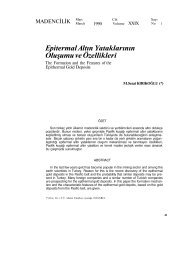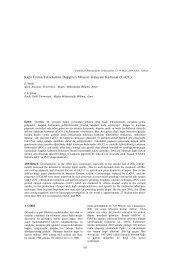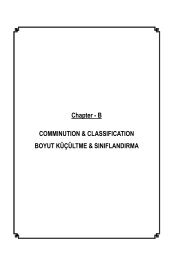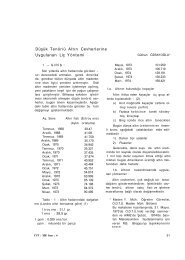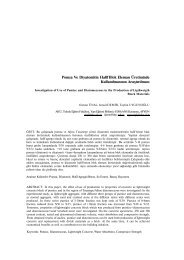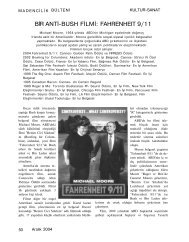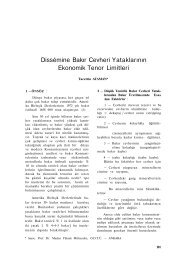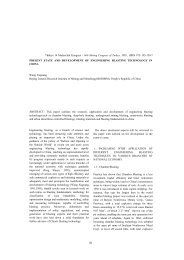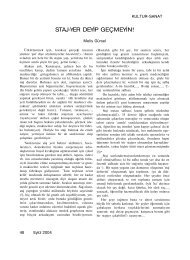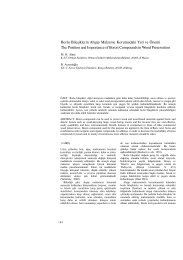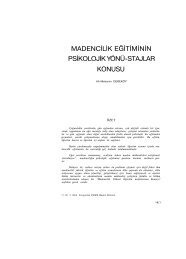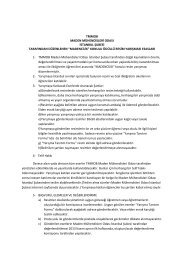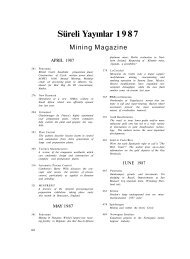A OPEN PIT MINING AÇIK OCAK MADENCİLİĞİ
A OPEN PIT MINING AÇIK OCAK MADENCİLİĞİ
A OPEN PIT MINING AÇIK OCAK MADENCİLİĞİ
You also want an ePaper? Increase the reach of your titles
YUMPU automatically turns print PDFs into web optimized ePapers that Google loves.
3 METHOLOGICAL APPROACH AND<br />
EQUIPMENT<br />
The close-range photogrammetric survey<br />
was performed with an UAV multirotor<br />
platform, assembled with OEM electronic<br />
components by Mikrokopter HiSystems<br />
GmbH. This platform is equipped with a<br />
Canon5D Mark II digital SLR camera and<br />
linked to a Ground Station control unit. For<br />
the acquisition of ground control points have<br />
been used a Topcon real-time kinematic<br />
(RTK) Global Positioning System (Tab. 1).<br />
This UAV photogrammetry system has<br />
been used to solve the problem of surveying<br />
the dangerous abandoned mining areas and<br />
to create surface models (DSMs) correctly<br />
interpolated, especially in areas of high<br />
steepness (vertical walls), and at risk of<br />
collapse.<br />
The DSMs were taken at different<br />
consistent resolutions using mainly two<br />
fixed focal lengths: 20mm and 35mm. These<br />
DSMs have been used as a basis to correlate<br />
the morphological characteristics of the site<br />
and the changes taking place, in order to<br />
understand the origin of the process of<br />
accelerated erosion and the consequent<br />
development of the network of surface<br />
runoff. Recently, several studies have<br />
shown that there is a close relationship<br />
between the resolution of the DEMs and the<br />
dimension of hydraulic model grid size<br />
(Claessens et al. 2005). With a ground<br />
sample resolution 1 m).<br />
Table 1. Equipment for aerial and terrestrial survey and data acquisition.<br />
The UAV system - Mikrokopter OEM HiSystems GmbH<br />
Positioning: Standalone GPS LEA-6S U-BLOX (accuracy 2.5 m)<br />
Diameter: 1 m - Net weight: 2000 g<br />
Power supply: Lithium-Polymer Accumulator (2 x 5000 mAh, 14.8 V)<br />
Take-off weight: 1600 g (with camera Canon Mark II 5D)<br />
Flight parameters radius and altitude: max 200 m – max 80 m<br />
Flight time: 10 min (with camera Canon Mark II 5D with fixed lenses)<br />
Number of mission (waypoints): 1 (9), 2 (55), 3 (19), 4 (40)<br />
The Camera system - Canon 5d Mark II<br />
Camera type: Full Frame (35.8x23.9 mm) CMOS<br />
Resolution sensor: 21 Mpixel CCD matrix - 5616 x 3744 – Raw16 bit<br />
Fixed lense: 20 mm - 50 mm precalibrated<br />
(Focal length (f x , f y), Principal point (c x , c y), K1, K2, K3, P1, P2)<br />
RMSE Calibration: 0.091 pix<br />
Stereo photos acquired in total aerial session: 284<br />
Overlap and Sidelap: >70% - >50%<br />
The GPS system - Topcon RTK-GPS Real-Time receiver<br />
Antenna: Legant GGD – Center of phase zero<br />
Receiver: Legacy-H GD 40 L1 GPS<br />
Datum and coordinates: WGS 84 – Geographic UTM-WGS 84<br />
Number of Satellites: 5-9 – 15 degree angle of visibility<br />
GPS points and GCP acquired in topography survey: 54 – 12<br />
RMSE < 2 cm<br />
86



